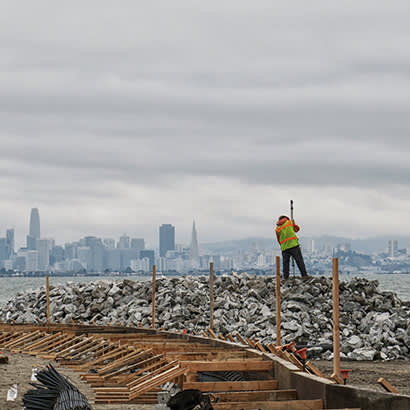
For an enhanced digital experience, read this story in the ezine.
The East Bay Regional Park District in Oakland, California, has a long history of community engagement. Over the years, thanks to legislative action and voter support, the park district has grown from 115,000 acres to more than 125,000 acres, preserving significant acreage of natural habitat and serving more communities through park and trail access. The park district currently manages nearly 200 miles of regional trails, serves 2.8 million residents and welcomes more than 25 million visitors a year.
Creating accessible parks and trails across biologically diverse lands and shorelines takes creativity and investment. The founding land survey, Proposed Park Reservations for East Bay Cities, highlighted that preserving land would be a minimal cost, but maintaining, operating and developing access to the land would require annual revenue. Revenue also would be needed to expand services, such as utilities, restrooms, picnic areas and other amenities. This insight, unique at the time, remains relevant today as the park district continues its expansion of new park areas while maintaining existing assets: all new and upgraded infrastructure need continued revenue and investment.
Over the past 30 years, the park district has led four significant voter-approved tax measures. These measures seed acquisition, environmental education and infrastructure investments. This funding is used with local, state and federal grants, such as those established by California State Park Bonds and the Land and Water Conservation Fund. A review of recently completed projects found nearly 88 percent of the park district’s large infrastructure has been funded by sources other than the general fund.
Examining the Economic and Social Impact
Wetland enhancements, trail connections and other infrastructure projects now require multiple sources to fund in full. These projects no longer cost thousands of dollars, but often millions. Acknowledging the increasingly significant level of public investment, the park district wanted to better understand the full community benefits of these large infrastructure projects. A recent economic study commissioned by the park district found that they not only support the community, but also directly support the local economy and jobs beyond park staff.
The East Bay Regional Park District Improvement Projects Economic and Social Impact Analysis by Beacon Economics identified large infrastructure projects to have direct, indirect and induced benefits. Direct benefits are derived from immediate spending by the park district’s construction and future day-to-day operations of project sites. Indirect benefits stem from the spending contractors and supplemental services expend in support of completing a park district project. Induced benefits come from the spending by those households associated with externally contracted work on a park district project. It is how they spend their income in the community. The report also quantifies the number of jobs created by job years. A job year equals one year of employment for one individual.
The analysis provided estimates for 93 upcoming green infrastructure projects. The one-time impact for these projects would be $214.4 million in economic output, 1,199 job years of employment, $107.1 million in labor income, and $25.4 million in tax revenue. Annually, the completed projects support $23.7 million in economic output, 131 job years, $13.4 million in labor income and $3.6 million in tax revenue.
Investing in Our Future
Community and elected official support help make bonds, grants and taxes possible to establish funding that supports the completion of projects. The funding approved by East Bay voters goes directly back into the local economy in the form of jobs, economic output and taxes. That, in turn, bolsters community support for the park district. It is a cycle of support, funding, project delivery and positive user experience that will bind the East Bay community with its regional park district for years to come.
Erich Pfuehler is Chief of Government and Legislative Affairs for East Bay Regional Park District (EBRPD). Lisa Baldinger is Legislative and Policy Management Analyst for EBRPD.

